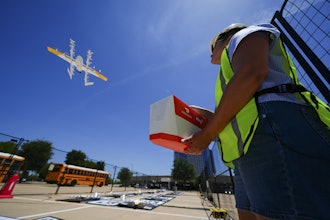
Other than conversation pieces, what’s the value in having decades-old machine tools occupy valuable floor space in a modern fab shop? The answer is “Plenty!” according to Ken Lennox, provided the machines are in suitable roles and were originally built with “the right stuff.” Lennox’s business, ETSM Technical Services Ltd., which he runs with his son, Matt, is an excellent case in point, with a mechanical brake from the fifties, a shear from the seventies, and a mid-eighties laser cutting system, all built by Cincinnati Incorporated. The three machines continue to be used daily at ETSM, within sight of state-of-the-art equipment that includes another Cincinnati brake and laser as new as 2011.
ETSM is a business in Guelph, Ontario, that manufactures its own product line of coil winding systems, enclosures and related equipment for the electrical transformer and utility industries, while producing custom fabrications, machine guarding, automotive fixturing and replacement parts for regional customers in energy, automotive and mining industries. The company has three principal lines of business: machining, powder coating and custom fabrication. It employs about 50 people and operates out of two production facilities totaling about 50,000 square feet. As a manufacturer of its own product line, the company has an engineering and controls department, as well as assembly capability. “Our engineering, assembly, machining, fabrication and finishing capabilities give us a lot of flexibility and many of our employees are multi-skilled,” says ETSM President Ken Lennox. “We’re a one-stop shop for fairly complex systems and machinery, while we can still make a nice profit doing repairs, one-off projects, or walk-in work.”
This 125-ton Cincinnati Series 5 mechanical press brake built in 1954 still does yeoman service for ETSM. ETSM upgraded the machine with a new CNC back gage. Company President Ken Lennox says it’s faster than a hydraulic brake on high production runs and performs very well if used within its capacity range. |
Lennox started the business in 1985 with used fabrication equipment that included a Cincinnati 5 Series 125-ton mechanical press brake made in1954, followed shortly by a used 18 Series shear with ¼-inch x 10 ft. capacity, built in 1974. The company’s first commercial laser cutting system was also a used Cincinnati CL-7 built in 1987 for the manufacturer’s own shop and used heavily for a couple of decades before being sold to a surplus dealer. “We have the technical resources in house to modernize these machines with current safety systems and guarding,” says Lennox. “We installed a CNC backgage on the press brake, and a new Fanuc control and servos on the laser system.”
Tactical advantages to keeping older machines in service
But why keep these machines in production when the company has a new Cincinnati CL-840 laser and newer 60CBII press brake, as well as other new equipment? “We often have work that we don’t want to use our new equipment for, or the old machines have a slight edge for some things,” he explains. “For example, we use the mechanical brake for lighter duty work that does not require its full capacity, such as straightening a fabrication we just made in our shop. This is a very tough, fast and durable machine. On a high-production run, it’s faster than a hydraulic brake so gives us a time advantage. There are worn components on it, but it still works great.
“We planned to retire the 1200-watt CL-7 laser when we got the 4000-watt 840, but we never quit using the older machine because it fills a niche for us. We do a lot of quick one-off pieces, and by keeping the older machine, we do not have to interrupt a production run on our higher-end laser. We can switch it from 20 ga. to ¼ inch plate quicker than the new machine because it’s lower-level technology – you just change the power settings and run it. It has the same 5 x 10 ft. table and swappable pallets. Admittedly, the older machine is slower with ballscrew drives and does not produce the same edge quality or accuracy as the new laser, but for a segment of our business, this is not an issue. The ability to get one part made in a few minutes, without interrupting our new laser, is a competitive advantage for some jobs.”
The company’s new Cincinnati CL-840 laser cutting system is a 4000-watt machine capable of cutting 20 ga steel at 1000 ipm with accu- racy of 0.001 inch. |
The newer CL-840 laser uses Cincinnati’s third-generation linear motor drives which combine with a 4000W resonator for up to 1000 ipm cutting of 20 gauge steel with ±0.001 inch accuracy. Like the older machine, its frame is built with heavyweight 0.75 to 1.5-inch steel plate, double the weight of other lasers, to resist the G-forces of linear motor acc/dec and deliver long service life in tough shop conditions. The machine uses dual 5 x 10 ft. quick-change pallets to enable offline load/unload and near-non-stop cutting.
Among the products manufactured in volume on the new laser are electrical enclosures that house phone and cable TV lines inside concrete light poles. ETSM makes about 5000 kits for these enclosures every year. The kit uses satin galvanized steel, aluminum and stainless steel. “Prior to our new laser, we outsourced everything but the mild steel, which we cut with our old laser,” Lennox explains. “The new laser allowed us to bring all this work in house, particularly the lighter gauge aluminum and stainless.” Other items fabricated in quantity at ETSM include development-size lots of parking lot equipment.
Likewise, the Cincinnati 18 Series shear made in 1974 continues to serve a role, after being purchased used more than 20 years ago. The machine was built in Cincinnati Incorporated’s former manufacturing plant in Scotland, sold to a customer in Israel, and then to a brake pad manufacturer in Montreal from whom Lennox bought the machine. “We use it every day and have no plans to replace it, despite having laser cutting ability,” Lennox stresses. “It’s pretty much maintenance-free. Just change the blades as needed and wipe the dust off. These older machines all still work, they rarely need maintenance, and there’s no cost to keep them on the floor. In fact, the older equipment is often easier to maintain because it’s simpler.”
Lessons from “under the hood”
Lennox says his early experiences at an employer’s shop shaped his views on equipment. “I learned my craft working under the hood of machine tools, repairing them and adding accessories/upgrades, so I know what to look for and it has made me a discriminating buyer of equipment,” he explains. “During those early years, I was all over Cincinnati machines at various times. In one case we built a feeder for a large press brake that was going to be used for curving multiplate tunnel liner. In another case, I had to repair the back gage on a 3/8” x 16 ft. Cincinnati shear. I learned that Cincinnati does not skimp on the material that is the foundation of the machine. What I saw of various types of equipment during that time still shapes my thinking today. There is something to be said for having lots of mass in a machine that’s going to be heavily used – and often abused – in a North American fab shop. Today, within any group of machine tools rated the same, there will be some that weigh a fraction of what others weigh. In my experience, the heavyweights survive better for the longest working lives.”
Those survivors will outlive their controls, Lennox emphasizes, so an upgrade path is important, as are current safety systems. “Cincinnati has an excellent control upgrade available for our 60-ton press brake built in 1998 with a 72-inch bed,” Lennox says. “We’re planning to replace our large foreign-built press brake with a Cincinnati in the future, and will implement the control upgrade for the 60CBII machine at that time so we can have one training and start-up period for two machines.”
As a builder of machine guarding, ETSM has the resources to keep its machines current with safety standards, too. The company has in-house capabilities for fabricating enclosures and perimeter guarding, and integrating sensors with machine control systems. The company also works with a safety consultant to ensure its shop and equipment meet current standards. Lennox says ETSM purchased its CL-840 laser with the Lexan enclosure and liked it so well that it plans to fabricate a similar enclosure for its older laser.
“There’s no capital cost to keep these older machines,” Lennox stresses. “As long as they stay healthy and we don’t need the floor space desperately, we’ll continue to use them because they fill an important tactical role in our business plan.”
For more information on Cincinnati lasers, brakes or shears, visit www.e-ci.com or contact Cincinnati Incorporated Box 11111, Cincinnati, OH 45211; phone: 513-367-7100; fax: 513-367-7552; email: [email protected].





















